Tuesday is to be travel day. We will leave the hotel at 7.30 to catch our uber for the Carib bus station. There we catch the bus for Cariari. The journey takes about two and a half hours. San Jose is on the elevated central plateau so the pass out is a bit up and a lot down. We are heading north east towards the Caribbean coast for Tortuguero. See original plan. This is the mountain view as we head down the road.
General view of one of the wider canals.
Anhinga again. Note blue ring in the eye denotes breeding season also notice hair like feathers on the neck.
Small Blue heron
Pair of Ibis.
As you can see the rain forest looks pretty impenetrable but once we drop down onto the coastal plain agriculture is the dominant feature. By the size of the huge haciendas there are some very large companies involved. Mile after mile of the same smart posts and fencing with tidy little villages at regular intervals means estate style industrial farming. Bananas seem to be the chief crop but mangoes, maize and cattle also loomed large. We see cowboys on horseback managing the cattle. Thank goodness I saw virtually no palm oil.
At Cariari we changed buses for the one to Pavona which is the inland port for Tortuguero and the nearest point for vehicular access. The picture below is us boarding the public transport boat at Pavona. Helen is just checking her case is safely boarded.
The river level was very low which caused a few problems. We bottomed out several times and when push comes to shove someone had to do the wet work. Despite being raised frequently the motor's propeller became damaged and needed floating repairs.
This is our eventual destination. The small village of Tortuguero which is also the centre for several other private resorts, which ranged from the smart to the exclusive. The foot soldiers like us stay in the range of lodges in the village with the locals. The attraction is two fold. The beach (about 100ms behind the buildings you can see) is the world's premier nesting site for the Green Sea Turtle. The water our boat is on is a lagoon off which runs river and canals which penetrate deep into the rain forest. The second attraction is to paddle silently through the forest and observe the wildlife.
This is our room, simple, clean and very colourful complete with octopuses on the beds.
The Caribbean Sea crashing onto the famous turtle nesting beach and a large bit of washed up lumber. The sea may be ok for turtles but it's not safe for humans to swim in. Turtle nesting season is March to October when the beach and sea are closed to all but scientists and highly controlled tourist groups. As we are outside the season the beach is pretty deserted at present.
Our guided paddle starts at 6am so it's an early start for our 3 hour experience. Our guide was excellent with amazing creature spotting abilities, especially as most animals rely on camouflage to survive. We saw many more things than we were able to successfully photograph, but have a look at a selection.
Firstly the Northern Jacana
The White-faced Capuchin, almost inevitably silhouetted by the light.
The Basillisk or Jesus Christ Lizard. It can walk on water. They can grow up to 1m in length though this one is about 50cms. Helen saw another one living up to his nickname.
The Anhinga or piano bird. The white feathers play louder than the black ones. Drying wings cormorant style.
General view of one of the wider canals.
Anhinga again. Note blue ring in the eye denotes breeding season also notice hair like feathers on the neck.
Cayman in waiting.
The well named Howler monkeys probably 2 adults and a juvenile.
Green heron.
Small Blue heron
Pair of Ibis.
Tiger heron's proud display.
At last the spider monkey.
Not great focus but a shot of a Variegated squirrel.
The ever present termite nest, how well they use the pre-existing architecture.
Green iguana, this fellas is about 1m long.
More things than you realise live up trees, particularly in this environment where they can offer security when asleep. This is a great shot of a relatively rare spot, a Boa Constrictor. These large snakes can grow to about 2.5 metres in length. This one is probably about 2 metres. Thank you Helen for this picture.
























Wow great photo's
ReplyDelete